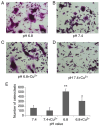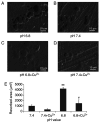Extracellular acidification stimulates OGR1 to modify osteoclast differentiation and activity through the Ca2+‑calcineurin‑NFATc1 pathway
- PMID: 39720672
- PMCID: PMC11667423
- DOI: 10.3892/etm.2024.12778
Extracellular acidification stimulates OGR1 to modify osteoclast differentiation and activity through the Ca2+‑calcineurin‑NFATc1 pathway
Abstract
The aim of the present study was to explore the role of ovarian cancer G protein-coupled receptor 1 (OGR1) in osteoclast differentiation and activity induced by extracellular acid. The impact of extracellular acidification on osteoclasts was investigated. Briefly, osteoclasts were generated from RAW 264.7 cells using 100 ng/ml receptor activator of nuclear factor-κB ligand in cell culture media at pH 6.8 or 7.4. Tartrate-resistant acid phosphatase (TRAP) staining and the bone resorption pit assay were used to detect the effects of extracellular acid on the number and absorptive capacity of osteoclasts. Intracellular Ca2+ levels were analyzed using laser scanning confocal microscopy. Reverse transcription-quantitative PCR was used to detect the expression levels of genes associated with osteoclast formation and bone erosion. The role of OGR1 in the acid-stimulated formation and bone resorption of osteoclasts was also investigated. The results showed that in the pH 6.8 medium group the number of osteoclasts was 511.2±54.72 and the area of bone absorption was 4,184.88±277.14 µm2; both were significantly higher than those in the pH 7.4 medium group (all P<0.01). Inhibition of OGR1 using copper ion (Cu2+) reduced the number of osteoclasts and the area of bone resorption in the pH 6.8 medium group (all P<0.05). Furthermore, extracellular acid (pH 6.8) was able to induce a transient increase of Ca2+ levels in osteoclasts; however, inhibition of OGR1 using Cu2+ effectively attenuated the acid-induced increase of Ca2+ in osteoclasts. In addition, the elevation in Ca2+ levels was inhibited when BAPTA, a cytoplasmic Ca2+ chelator with cellular permeability, was added to the cells; however, the extracellular Ca2+-chelating agent ethylene glycol tetraacetic acid did not inhibit the acid-stimulated increase in Ca2+. Treatment with the phospholipase C inhibitor U73122 also inhibited the acid-stimulated increase of Ca2+ in osteoclasts. Furthermore, the mRNA expression levels of TRAP, matrix metalloproteinase-9, osteoclast-related receptor, nuclear factor-activated T cell 1 (NFATc1), cathepsin K and integrin β3 were elevated in the pH 6.8 medium group compared with those in the pH 7.4 medium group (all P<0.05). By contrast, the inhibition of OGR1 using Cu2+ partially reduced the effects of the acidic environment on osteoclast differentiation and activity-related gene expression (all P<0.05). In addition, the mRNA and protein expression levels of calcineurin were increased in osteoclasts in the pH 6.8 group compared with those in the pH 7.4 group (P<0.05), whereas blocking OGR1 suppressed the expression of acid-induced calcineurin. The mRNA expression levels of NFATc1 in osteoclasts were also increased in the pH 6.8 medium group compared with those in the pH 7.4 medium group (P<0.05). By contrast, the specific calcineurin inhibitor cyclosporine A significantly inhibited the acid-induced expression of NFATc1 in osteoclasts. In conclusion, the present study revealed that extracellular acidification may increase osteoclast differentiation and bone resorption activity. Furthermore, OGR1-mediated Ca2+ elevation could have a crucial role in osteoclasts by regulating the Ca2+-calcineurin-NFATc1 signaling pathway and downstream signaling.
Keywords: acidosis; osteoclast; ovarian cancer G protein-coupled receptor 1; proton sensing receptor.
Copyright: © 2024 Li et al.
Conflict of interest statement
The authors declare that they have no competing interests.
Figures





Similar articles
-
Extracellular acidification enhances osteoclast survival through an NFAT-independent, protein kinase C-dependent pathway.Bone. 2008 Jan;42(1):150-61. doi: 10.1016/j.bone.2007.08.044. Epub 2007 Sep 14. Bone. 2008. PMID: 17964236
-
Convergent signaling by acidosis and receptor activator of NF-kappaB ligand (RANKL) on the calcium/calcineurin/NFAT pathway in osteoclasts.Proc Natl Acad Sci U S A. 2005 Feb 15;102(7):2643-8. doi: 10.1073/pnas.0406874102. Epub 2005 Feb 4. Proc Natl Acad Sci U S A. 2005. PMID: 15695591 Free PMC article.
-
Deletion of the proton receptor OGR1 in mouse osteoclasts impairs metabolic acidosis-induced bone resorption.Kidney Int. 2021 Mar;99(3):609-619. doi: 10.1016/j.kint.2020.10.023. Epub 2020 Nov 4. Kidney Int. 2021. PMID: 33159961
-
Knockdown of TRPV4 suppresses osteoclast differentiation and osteoporosis by inhibiting autophagy through Ca2+ -calcineurin-NFATc1 pathway.J Cell Physiol. 2019 May;234(5):6831-6841. doi: 10.1002/jcp.27432. Epub 2018 Nov 1. J Cell Physiol. 2019. PMID: 30387123
-
Calcium signaling in osteoclast differentiation and bone resorption.Adv Exp Med Biol. 2012;740:917-32. doi: 10.1007/978-94-007-2888-2_41. Adv Exp Med Biol. 2012. PMID: 22453976 Review.
References
LinkOut - more resources
Full Text Sources
Miscellaneous
